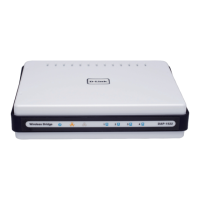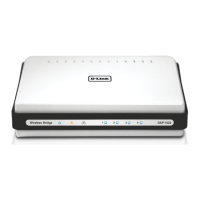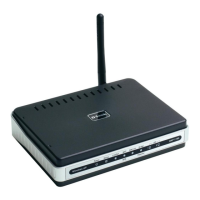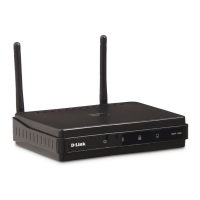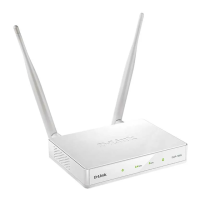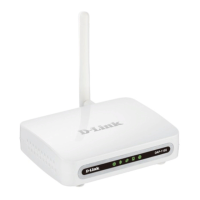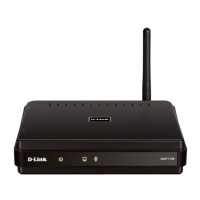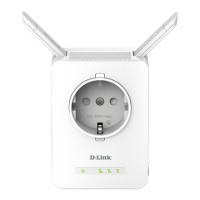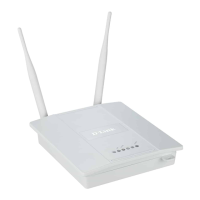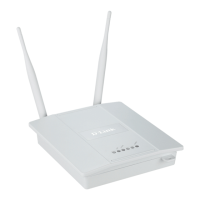
Do you have a question about the D-Link DAP-1513 and is the answer not in the manual?
| Frequency Band | 2.4 GHz |
|---|---|
| Wireless Speed | Up to 300 Mbps |
| Antenna Type | Internal |
| Antennas | 2 |
| Dimensions | 147.5 x 112 x 33 mm (5.81 x 4.41 x 1.3 inches) |
| Weight | 220 g (7.76 oz) |
| Wireless Standards | IEEE 802.11n |
| Ports | Ethernet |
| Security | WPA/WPA2 |
| Operating Modes | Access Point |
Lists the items included in the product package, such as the MediaBridge, Ethernet cable, power adapter, and CD-ROM.
Details network and browser requirements for using the MediaBridge's web-based configuration utility.
Introduces the D-Link DAP-1513 MediaBridge, its features, and benefits like high-speed wireless access.
Highlights core features such as faster wireless networking, IEEE 802.11g compatibility, WPS, and setup wizard.
Identifies and explains the physical ports and buttons on the device, including LAN ports, power receptor, and reset button.
Explains the status indicators (LEDs) on the device, their meaning, and what they signify during operation.
Details the function of the WPS button for initiating wireless device connection processes.
Explains how the DAP-1513 functions as a wireless network bridge and how to connect Ethernet devices.
Provides guidelines for optimal placement and environmental factors to maximize wireless signal range and performance.
Guides the user through the initial setup process for the MediaBridge using the web-based configuration utility.
Explains the options for configuring the wireless client, including WPS and manual setup methods.
Details steps for manual configuration, including finding the wireless network name (SSID) and connecting.
Guides the user to select the wireless security mode and enter the necessary password for encryption.
Explains how to access and use the web-based configuration utility to change settings or optimize performance.
Instructs on launching the Wireless Setup Wizard for easy configuration or accessing Wireless Setup manually.
Provides detailed steps for manual wireless setup, including network name, channel, mode, and security settings.
Explains how to configure local network settings, including IP address, subnet mask, and device name via DHCP.
Guides the user on setting a static IP address for the MediaBridge, including subnet mask and gateway.
Covers advanced wireless configurations like transmit power, advising caution for optimal performance.
Details how to change the Administrator password and enable graphical authentication for security.
Explains options to save current settings, upload previous configurations, restore factory defaults, and reboot.
Guides on updating the device firmware and language packs, emphasizing the need for a wired connection.
Covers setting the device's time zone, daylight saving, and using NTP for automatic time synchronization.
Displays current information about the MediaBridge, including general, LAN, and wireless LAN details.
Explains how to view, save, and manage device logs for troubleshooting and activity monitoring.
Shows traffic statistics for LAN and wireless connections, including sent/received packets and errors.
Provides access to help information for various sections of the GUI, assisting users with setup and configuration.
Outlines the different levels of wireless security offered by the DAP-1513, including WPA and WPA2.
Explains WPA/WPA2 security standards, their improvements over WEP, and authentication methods.
Provides step-by-step instructions on how to configure WPA/WPA2 Personal security for wireless connections.
Offers solutions for common issues preventing access to the web-based configuration utility, like browser or connectivity problems.
Explains how to reset the MediaBridge to factory defaults if the administrator password is forgotten.
Details how to check the device's IP address using the command prompt, essential for network diagnostics.
Guides users on how to manually assign a static IP address to the MediaBridge via Windows settings.
Lists detailed technical specifications of the DAP-1513, including standards, security, signal rates, and dimensions.
Provides contact information and essential details needed when contacting D-Link technical support for assistance.
Outlines the limited warranty terms for the D-Link product, including coverage, duration, and customer remedies.
Lists exclusions from the limited warranty, such as damage from misuse, accidents, or unauthorized modifications.
Provides FCC and Industry Canada compliance information and statements regarding radio frequency interference.
Encourages product registration online and states that it is voluntary and does not affect warranty rights.
